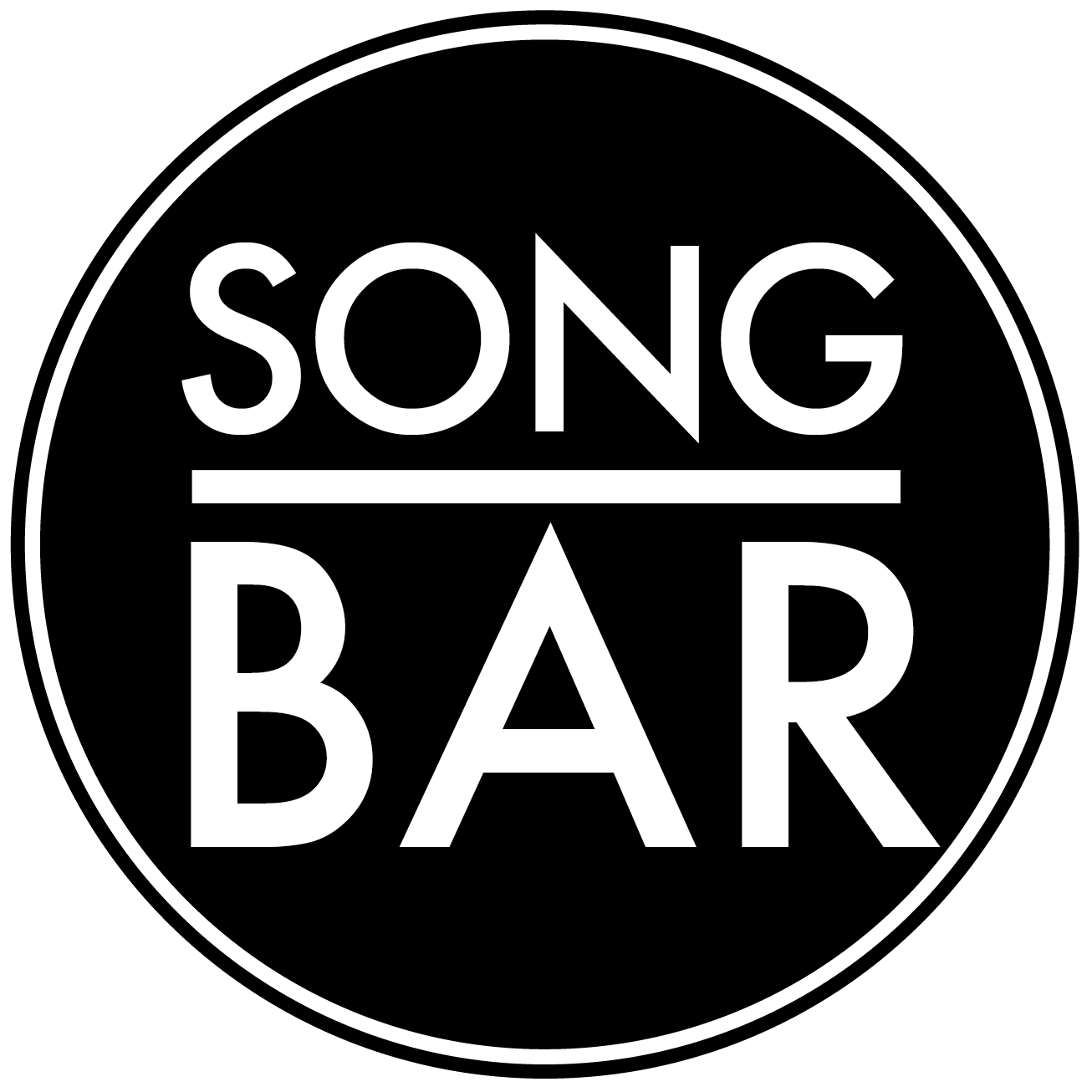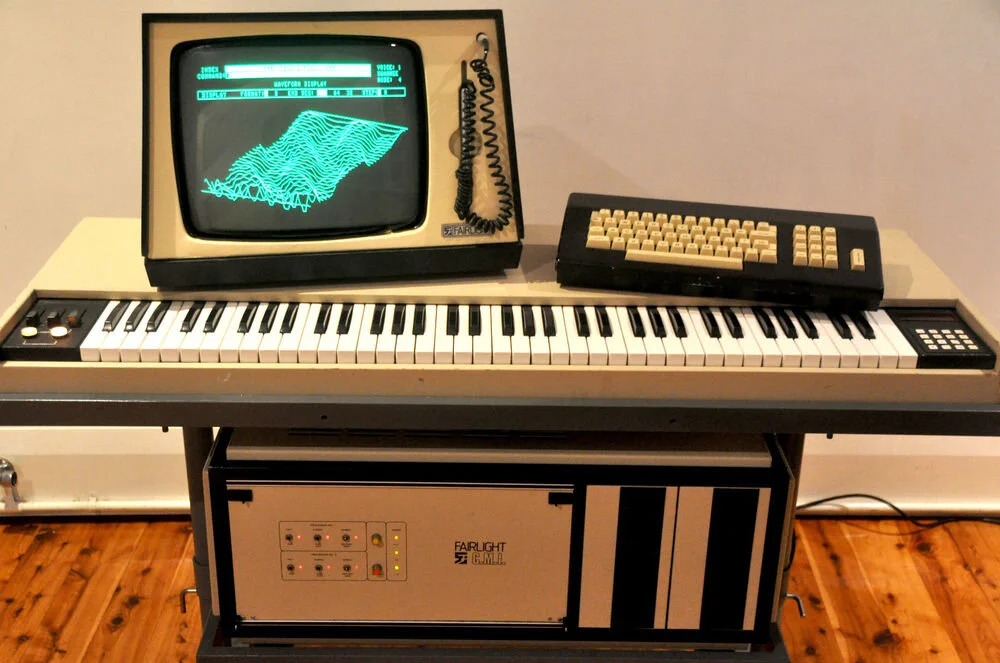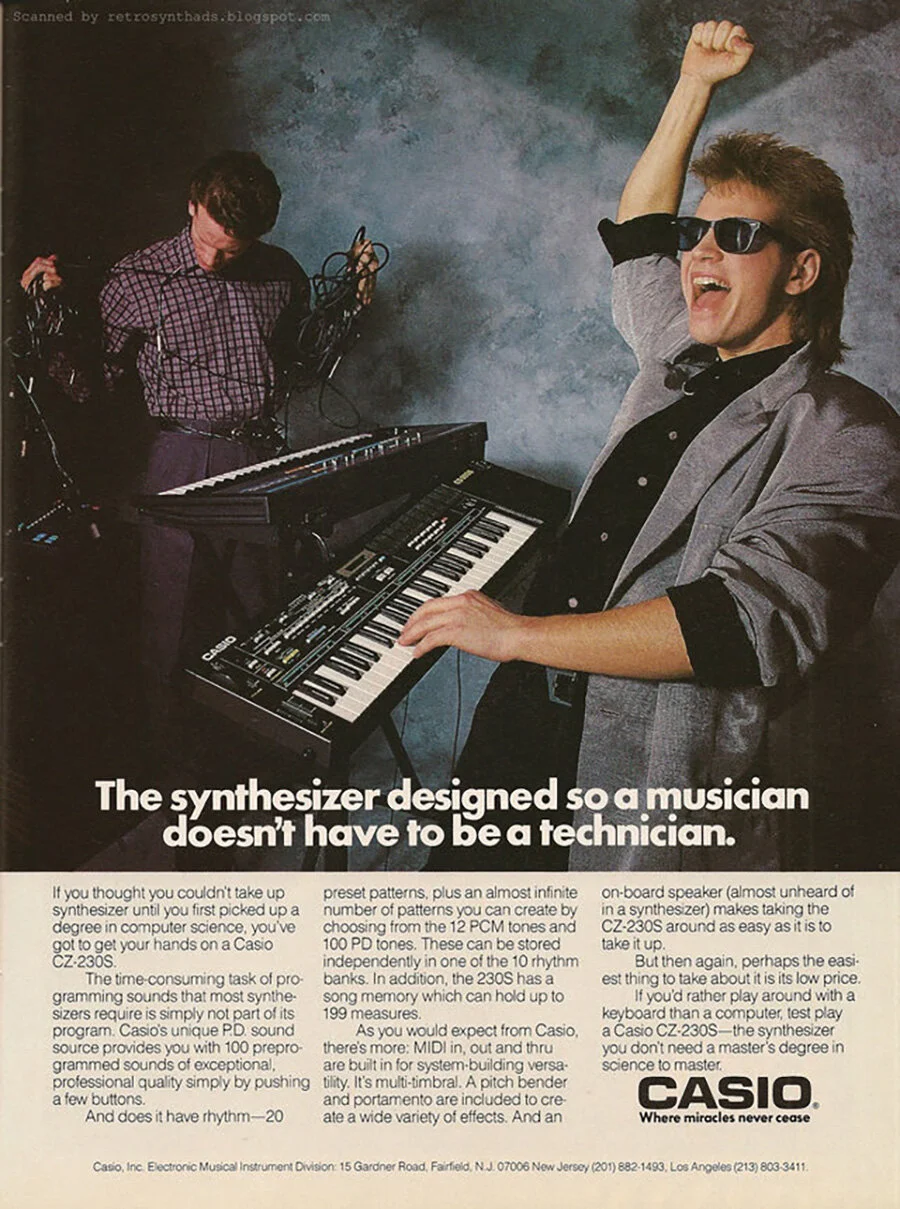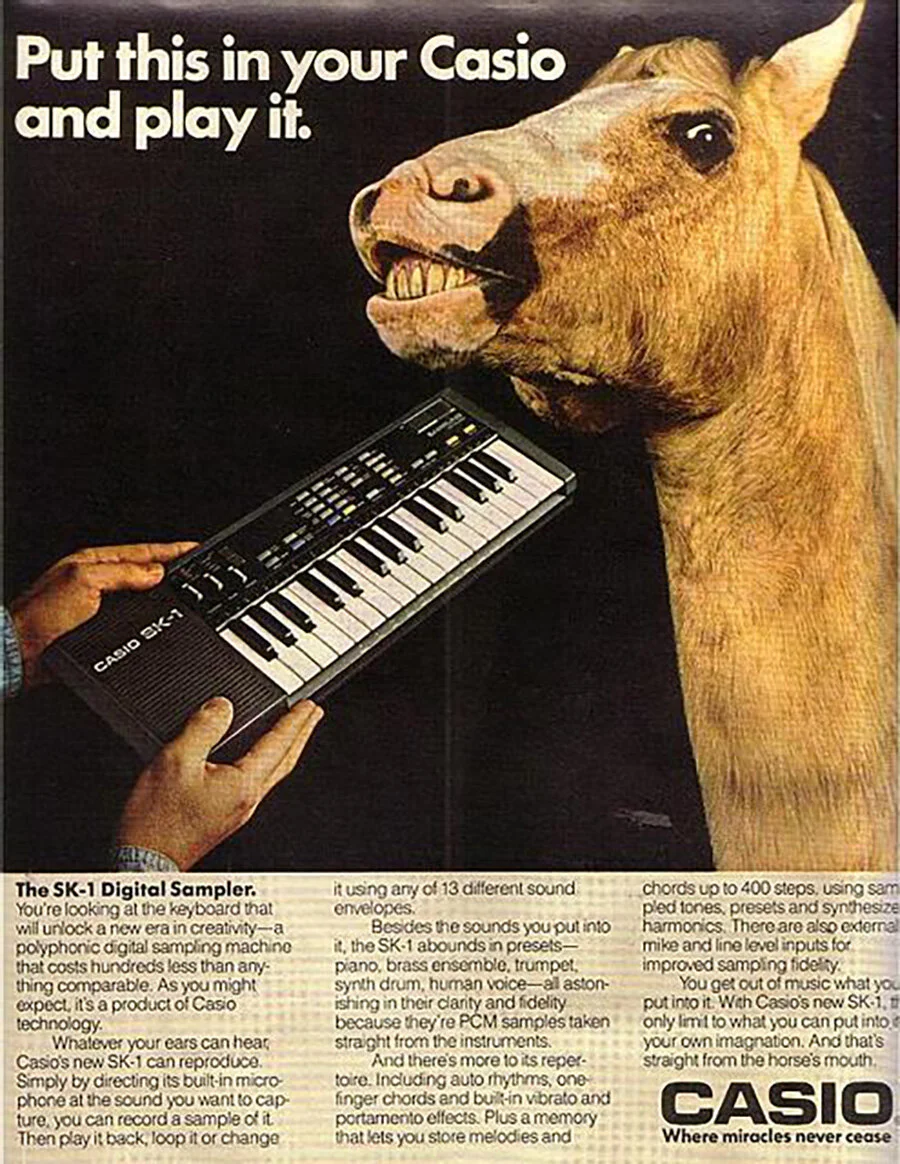By The Landlord
"My concept is that is no border between music and noise. The world is full of sounds. We just don't usually hear them as music." – Ryuichi Sakamoto
"I used to do all my programming on a BBC computer. It was limited to 16 tracks, and you used the keyboard, not a mouse, to input, but I was using it so long, I got quite fast at it." – Vince Clarke
“The voice I use is a very old hardware speech synthesizer made in 1986. I keep it because I have not heard a voice I like better and because I have identified with it.” – Stephen Hawking
"The synth helped us in that it meant you didn't have to be a traditional four-piece band." – Curt Smith
"In New Order, I played about 95% of the synth parts. It was not much fun for the other guys." – Bernard Sumner
Three-and-a-half years ago here at Song Bar we delved deeply into the bleeps, buzzes and soundwaves of electronic music and songs up to 1983. It began with a look at the early 20th-century mechanical L'Arte dei Rumori (The Art of Noises), inventions of Italian futurist Luigi Russolo that inspired vast array of emerging electronic experimentalists across Europe, Japan and America, moving towards 1950s and 60s pioneers, including Robert Moog, Wendy Carlos, Delia Derbyshire, then, in the 1970s, Kraftwerk and The Yellow Magic Orchestra. And from many hundreds of nominations and oddball sounds, fabulous playlists emerged.
All of this is worth a revisit, as it garners so much joy and discovery, but this time, we're taking up that baton, and buttons, and moving to the next phase, or indeed phaser, where, from the early 1980s, after the bigger analogue machines, digital synthesizers and MIDI began to make their mark on popular music and more, expanding on the work of the giants who came before them, using the fast-developing technology at their fingertips, with new synth sounds, samplers, sequencers, and drum machines to embellish and develop the whole genre.
With such huge sonic palette, this could potentially be a vast and unwieldy prospect, but just to focus those sounds a little, the emphasis is less on the ambient branch of electronica, which could easily be a whole other topic for the future, nor is it on the totally lyric-less dance genre (we already explored dance instrumentals last Christmas). So it is more particularly towards synth pop and electronic songs, in other words, those genres where some sort of rhythm and beats are involved, where often bodies are inspired to move, but also words sung, even minimally.
So, example, it could begin with those Sheffield experimentalists turned pop artists The Human League, or Depeche Mode, or The Art of Noise and the ZTT Records label, all the way up to the late 1990s, a decade where, after a very rich patch of pop, US grunge and Britpop took more of a stranglehold on commercial success, but in all the time electronic dance and synth pop were thriving in their own corners, from club sounds to crossover bands such as Stereolab, Massive Attack, Faithless and Tricky, or the purely electronic and commercially successful Air or Daft Punk.
But of course these are just examples of the better known, and there are many more artists to be shared and discovered across this period. That is what Song Bar is for, after all. And if anything, the overall aim is to gather a sense of those key moments, those songs that captured an era, that made advances, those classic synth sounds and beats, and to gather a sense of the shape and arc of this slice of music's history, of how it moved over a period of two decades. There's a slight overlap with the topic that went up to 1983 here, but also allowing the whole of the 1980s can help fill out the sounds of the era as new and older technology mixed. Everything electronica in the new millennium can be saved for a future time.
A Fairlight CMI synthesizer and sampler in 1983
While electronic music technology offers a suite of so many sounds, its music could potentially be mind-bogglingly complex, it is often the simplest that turned out to be most effective. And after all, a good melody is the same in any kind of music. As Pete Seeger, who of course worked in an entirely different form, but still knew all about songwriting, put it: "“Any damn fool can make something complex; it takes a genius to make something simple.”
So stripping back all the helicopter noises and silly options available to synth players, what sounds in electronic and synth pop press your buttons? What timbre of beats twitches your switch?
The late 70s and early 80s presented musicians with new suite of options, and perhaps the most prominent change was the advent of 1979’s Fairlight CMI digital synthesiser, sampler and digital audio workstation. Here’s an eccentric demonstration on BBC1’s Tomorrow’s World, a machine that, while clunky to use by today’s standards made any sound possible.
Many musicians, such Jean-Michel Jarre as well as Sakamoto, continued to produce music using older equipment as well as new. “To me, the original VCS3 synthesizer is like a Stradivarius,” said Jarre of the model created in the 1960s, and this topic doesn’t exclude work using such items, as long as they were released from the 1980s onwards.
Of the new technology at the time, the Fairlight was extremely expensive, estimated at around £70,000, but its fans came from many forms of music. The first person to buy it in the UK was Led Zeppelin bassist John Paul Jones, but it was also rapidly adopted by including Kate Bush, Geoff Downes, Trevor Horn, Alan Parsons, Rick Wright and Thomas Dolby, and in the US A Stevie Wonder, Herbie Hancock, Jan Hammer, Todd Rundgren and Joni Mitchell.
The analogue synth raised the eyebrows of many an angry rocker in the 1970s just as disco started a mass burning of records, and this flashy new technology had a the similar response in some quarters, but Trevor Horn, notably with The Art of Noise, was unapologetic: “When we started making electronic music I imagined that the reaction we got from the rock musicians must have been similar to the one the beat groups got from people like my dad.”
Electronic equipment was adopted by many rockers. Dusty Hill of ZZ Top attributed one of his bands biggest hits, Legs, to a strong synth bass sound.
As well as higher end equipment, the 80s saw a mass market of cheaper items made for the bedroom musician, something to compete with the guitar, something that was designed to be sexy rather than nerdy, and easy to use rather than complicated. It ushered in a whole range of new sounds that ranged from the plasticky to the revolutionary, and ones which will stir many a memory.
Here’s a little selection of synth advertisements from the 1980s from simple Casiotone keyboards and samplers to drum pads, the Yamaha portable guitar-style keyboard and the Rapman. Here it was then, a whole new world of creativity, craft as well as crappiness, open to the mass market for anyone to make at an affordable price. Something to cringe at as well as cherish:
Magazine advertisements also captured the accessibility and the ease of it all:
Casio trotted out many items such as he CZ-230S and SK-1 until we were hoarse.
From the Casio CZ-101 mini keyboard sample to the Roland TB-303, a bass synthesizer and sequencer released in late 1981, or a from the cheap and cheerful, there’s a range of instruments that have become vintage classics, from the Yamaha DX 7 to Roland D-50, Juno 60 to Korg M1. For inspiration, here’s a handy video with some examples of where they were used:
Further famous examples fo the Oberheim OB-Xa’s sounds include Prince’s ‘1999’ or that fat synth line on Van Halen’s ‘Jump’. Or you might fancy a go on the Sequential Circuits Prophet 5, which includes key parts of Tears For Fears’ Everybody Wants To Rule The World and Talking Heads’ This Must Be The Place The Yamaha DX7 synth, using 32 patches was another very popular instrument in pop and beyond and prominent hits utilising its sounds are Madonna’s Like A Prayer, and A-Ha’s Take On Me. Roland rolled out so many models, some more successful than others.
The Roland SH-101 was a commercial flop and was discontinued in 1986, but rediscovered by the burgeoning producers of techno, house and drum ’n bass music in the early ’90s, with notable fans including Aphex Twin, The Prodigy and Squarepusher.
Last, but by no means least, is the Roland TR-808, created by Ace Tone president and founder Ikutaro Kakehashi, a drum machine with a distinctive sound that helped launched thousands of songs, filled with idiosyncratic sounds, from that deep booming bass drum, snare, toms, conga, handclap, rimshot, claves, maraca, cowbell, cymbal, and hi-hat (open and closed). Small and portable and affordable, it became a cornerstone of the emerging electronic, dance, and hip hop genres, popularised by early hit uses such as Sexual Healing by Marvin Gaye, though that may be its least attractive quality, and Planet Rock by Afrika Bambaataa and the Soulsonic Force, as well a whole dance culture in the north of England.
The classic Roland TR-808
But that’s enough words and sounds from me. What buttons will you press. Manning the big console behind the bar this week, I’m delighted to welcome back to a second stint, the marvellous MussoliniHeadkick! Place your electronic and synth pop numbers in comments box below for deadline at 11pm UK on Monday for playlists published next week. Time to power up …
New to comment? It is quick and easy. You just need to login to Disqus once. All is explained in About/FAQs ...
Fancy a turn behind the pumps at The Song Bar? Care to choose a playlist from songs nominated and write something about it? Then feel free to contact The Song Bar here, or try the usual email address. Also please follow us social media: Song Bar Twitter, Song Bar Facebook. Song Bar YouTube, and Song Bar Instagram. Please subscribe, follow and share.
Song Bar is non-profit and is simply about sharing great music. We don’t do clickbait or advertisements. Please make any donation to help keep the Bar running:





